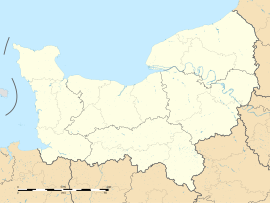Breteuil, Eure
Breteuil | |
|---|---|
 The town hall in Breteuil | |
| Coordinates: 48°50′13″N 0°54′53″E / 48.8369°N 0.9147°E | |
| Country | France |
| Region | Normandy |
| Department | Eure |
| Arrondissement | Bernay |
| Canton | Breteuil |
| Intercommunality | Normandie Sud Eure |
| Government | |
| • Mayor (2020–2026) | Gérard Chéron[1] |
Area 1 | 55.05 km2 (21.25 sq mi) |
| Population (2022)[2] | 4,284 |
| • Density | 78/km2 (200/sq mi) |
| Demonym | Bretoliens |
| Time zone | UTC+01:00 (CET) |
| • Summer (DST) | UTC+02:00 (CEST) |
| INSEE/Postal code | 27112 /27160 |
| Elevation | 157–197 m (515–646 ft) (avg. 179 m or 587 ft) |
| 1 French Land Register data, which excludes lakes, ponds, glaciers > 1 km2 (0.386 sq mi or 247 acres) and river estuaries. | |
Breteuil (French pronunciation: [bʁətœj]), also known as Breteuil-sur-Iton ("Breteuil-on-Iton"), is a commune in the Eure department in Normandy in northern France. On 1 January 2016, the former communes Cintray and La Guéroulde were merged into Breteuil.[3]
History
[edit]During the Middle Ages, Breteuil was the seat of a lordship in the duchy of Normandy. Its lord William FitzOsbern was a companion of William during his conquest of England in 1066. His son William of Breteuil served as a Benedictine abbot before inheriting Breteuil and was later canonized as a saint by the Roman Catholic Church. His illegitimate son Eustace of Breteuil married Juliane de Fontevrault, the illegitimate daughter of King Henry I of England, who feuded with her father and eventually lost control of the lordship.
In 1356, as it had sided with the English, Breteuil was under siege by the king of France, John II (r. 1350–1364). It was relieved in late June after Edward III of England (r. 1327–1377) diverted to Normandy an expedition under Henry of Lancaster, originally planned for Brittany. This strategy aimed at building on discontent and outright rebellion in Normandy against the unpopular French king, and caused John II to retreat to Rouen.
After subsequently failing to bring the English force to battle, the French King returned to Breteuil and re-established the siege. This continued to distract him from the English preparations for a greater chevauchée from south-west France.[4][5] At some point in August an unusually large belfry, or mobile siege tower, was pushed up to the walls of Breteuil and a full-scale assault launched. The defenders set fire to the belfry and repulsed the attack. The historian Kenneth Fowler describes the siege as "magnificent but archaic".[6]
Eventually John had to give way to the pressure to do something to prevent the destruction being inflicted in south-west France. Sometime around 20 August he offered the garrison of Breteuil free passage, a huge bribe and permission to take with them their valuables and goods, which persuaded them to vacate the town.
Population
[edit]| Year | Pop. | ±% p.a. |
|---|---|---|
| 1968 | 3,976 | — |
| 1975 | 4,259 | +0.99% |
| 1982 | 4,219 | −0.13% |
| 1990 | 4,280 | +0.18% |
| 1999 | 4,456 | +0.45% |
| 2007 | 4,521 | +0.18% |
| 2012 | 4,553 | +0.14% |
| 2017 | 4,424 | −0.57% |
| Source: INSEE[7] | ||
See also
[edit]References
[edit]- ^ "Répertoire national des élus: les maires" (in French). data.gouv.fr, Plateforme ouverte des données publiques françaises. 13 September 2022.
- ^ "Populations de référence 2022" (in French). The National Institute of Statistics and Economic Studies. 19 December 2024.
- ^ Arrêté préfectoral 9 December 2015 (in French)
- ^ * Fowler, Kenneth (1969). The King's Lieutenant: Henry of Grosmont, First Duke of Lancaster, 1310–1361. New York: Barnes & Noble. ISBN 978-0-389-01003-6. p. 153
- ^ Rogers, Clifford J. (2014) [2000]. War Cruel and Sharp: English Strategy under Edward III, 1327–1360. Woodbridge, Suffolk: Boydell Press. ISBN 978-0-85115-804-4. pp. 342
- ^ * Fowler, Kenneth (1969). The King's Lieutenant: Henry of Grosmont, First Duke of Lancaster, 1310–1361. New York: Barnes & Noble. ISBN 978-0-389-01003-6. p. 154
- ^ Population en historique depuis 1968, INSEE




